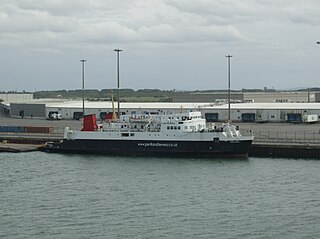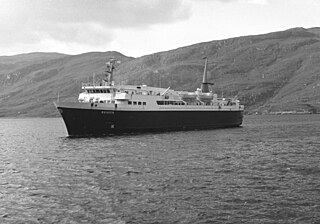
MV Isle of Lewis is a Scottish ro-ro ferry, owned by Caledonian Maritime Assets, and operated by Caledonian MacBrayne between Oban and Castlebay, Barra. Built in 1995, she remains one of only two ships in the CalMac fleet over 100 metres (328 ft) in length; the other, Loch Seaforth, being longer by almost 15 metres.

MV Clansman is a ferry owned by Caledonian Maritime Assets Limited and operated by Caledonian MacBrayne, operating from Oban on the west coast of Scotland.

The Caledonian MacBrayne fleet is the largest fleet of car and passenger ferries in the United Kingdom, with 34 units in operation and another 2 under construction. The company provides lifeline services to 23 islands off the west coast of Scotland, as well as operating routes in the Firth of Clyde.

MV Lord of the Isles is one of the larger Caledonian Maritime Assets Limited ferries, run by Caledonian MacBrayne and largely operating from Mallaig on the west of Scotland. Built in Port Glasgow, she is the most-travelled vessel in the CalMac fleet.

MV Isle of Mull is one of the larger Caledonian Maritime Assets Limited ferries operated by Caledonian MacBrayne from Oban on the west of Scotland.

MV Hebrides is a ferry owned by Caledonian Maritime Assets Limited and operated by Caledonian MacBrayne from Uig to Lochmaddy and Tarbert, the main settlements of North Uist and Harris respectively.

MV Hebridean Isles is a ro-ro vehicle ferry owned by Caledonian Maritime Assets and operated by Caledonian MacBrayne on the west coast of Scotland. She was the first MacBrayne vessel to be built outside Scotland and the first to be launched sideways. With bow, stern and side ramps, Hebridean Isles is suitable for all the routes served by the large fleet units. After 15 years crossing the Little Minch on the Uig triangle, she now serves Islay.

MV Isle of Arran is a drive-through ferry owned by Caledonian Maritime Assets Limited and operated on the west coast of Scotland by Caledonian MacBrayne. Entering service in 1984, she served on the Arran service for nine years before being moved to Kennacraig. She returned to her original route in 2012, supplementing MV Caledonian Isles in summer and becoming a relief vessel in winter. In 2013, she started a new pilot route from Ardrossan to Campbeltown, which became a permanent fixture in 2015. As of 2022, she is one of the oldest vessels in the fleet, having been in service for 38 years.

MV Pioneer is a stern / side loading ferry built in 1974, in service for 29 years covering nearly all of Caledonian MacBrayne's routes. She now serves the islands of São Tomé and Príncipe in the Gulf of Guinea and was chartered to rescue Liberian refugees.

MV Pentalina-B was a fast and extremely versatile ferry which operated on a variety of Scottish routes. Launched in 1970 as MV Iona, she was the first drive-through roll-on/roll-off ferry built for the David MacBrayne fleet. She was the first ship in the company's history to have bridge-controlled engines and geared transmission, rather than direct drive. She enjoyed a far-flung career and inaugurated more endloading linkspans than the rest of the fleet put together. Purchased by Pentland Ferries in 1997, she was renamed MV Pentalina-B and operated across the Pentland Firth until the arrival of their new vessel. In 2009, she was sold to a Cape Verde owner.

MV Hebridean Princess is a cruise ship operated by Hebridean Island Cruises. She started life as the MacBrayne car ferry and Royal Mail Ship, initially RMS then MV Columba, based in Oban for the first 25 years of her life, carrying up to 600 passengers, and 50 cars, between the Scottish islands.

MV Isle of Cumbrae is a Caledonian Maritime Assets Limited ro-ro car ferry, built in 1976 and operated by Caledonian MacBrayne. For ten years she was at Largs and operated the Loch Fyne crossing from 1999 to 2014. She was replaced by the MV Lochinvar in 2014, a new diesel-electric hybrid ferry capable of holding 23 cars and 150 passengers. She returned to Tarbert in 2016 after MV Lochinvar was moved to the Mallaig - Armadale station. She is now the oldest vessel in the Calmac fleet.

MV Muirneag is a ro-ro freight ferry, built in 1979 as MV Mercandian Carrier. From 1986 to 2002, she was named MV Belard, serving initially across the Irish Sea. From 2002 to 2013, she was chartered by Caledonian MacBrayne on the Stornoway to Ullapool freight crossing, until she was replaced by Clipper Ranger.

MV Hebrides was the first of a trio of hoist-loading car ferries built for David MacBrayne Ltd in 1964 and operated on the Uig, Skye to Tarbert and Lochmaddy route in Scotland for over twenty years. She is the only Calmac vessel to have crossed the Atlantic. In later years, as Illyria she sailed between Italy and Albania.
MV Lochmor was the David MacBrayne Ltd Outer Isles mail steamer from 1930 until 1964. She was superseded by a new generation of car ferries.

MV Loch Seaforth was the Stornoway mailboat operated by David MacBrayne Ltd, from 1947 until 1972. Running aground and sinking in 1973, she blocked the Tiree pier, until removed for scrapping.
MV Bute was a Clyde vehicle ferry introduced by Caledonian Steam Packet Company in 1954. She spent 24 years on the Upper Clyde crossings. During her final years with Calmac, she relieved in the west highlands.
MV Cowal was a hoist-loading vehicle ferry introduced by Caledonian Steam Packet Company in 1954. She spent the whole of her 24 years with Caledonian MacBrayne on the Upper Clyde crossings.

MV Suilven was a vehicle ferry built in 1974 and operated for 21 years by Caledonian MacBrayne on the Ullapool to Stornoway route. She subsequently operated in New Zealand and later in Fiji.

MV Loch Seaforth is a Caledonian Maritime Assets ferry operated by Caledonian MacBrayne between Stornoway and Ullapool. She was launched on 21 March 2014 and entered service in mid-February 2015, replacing both the former vessel, 1995-built MV Isle of Lewis and a chartered freight vessel.


















